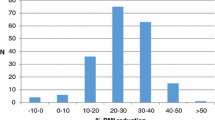Abstract
Background
Male gender has been associated with a higher morbidity and mortality rate after bariatric surgery including laparoscopic and open procedures. This study focused on hand-assisted laparoscopic Roux-en-Y gastric bypass and morbidity and mortality among genders.
Methods
Hand-assisted laparoscopic Roux-en-Y gastric bypass operations (N = 319) were evaluated from October 2003 to March 2006. Comparison between males (N = 54) and females (N = 265) were conducted using t test or Fishers exact test and chi-square analysis.
Results
Patients’ average age was 42.3 ± 10.3 and the average body mass index (BMI) was 49.2 ± 7.9. There was no significant difference between males and females in age or BMI. Males had a significantly greater average weight than females (p < 0.001) and were significantly more likely to experience sleep apnea (p = 0.006) and have heart disease (p = 0.017). For operative risk factors, males had a significantly longer anesthesia time (p = 0.003), operative time (p = 0.027), and length of roux limb (p = 0.038). At 6 and 12 months postsurgery, there was no significant difference between males and females with complications. Although BMI did not differ significantly, males continued to weigh significantly more than females and lost significantly more pounds than did females at both 6 and 12 months postoperation.
Conclusion
Given their larger size and tendency to accumulate fat in the abdominal compartment that increases the technical difficulty of the procedure, males are historically associated with a higher morbidity and mortality following bariatric surgery. Based on the current study, however, there is no difference in outcome among genders following hand-assisted laparoscopic Roux-en-Y gastric bypass.
Similar content being viewed by others
Abbreviations
- BMI:
-
body mass index
- CHF:
-
congestive heart failure
- DVT:
-
deep vein thrombosis
- GI:
-
gastrointestinal bleed
- GJ:
-
gastrojejunostomy
- HALRGBP:
-
hand-assisted laparoscopic Roux-en-Y gastric bypass
- ICU:
-
intensive care unit
- JJ:
-
jejunojejunostomy
- PE:
-
pulmonary embolism
- RYBGP:
-
Roux-en-Y gastric bypass
References
Livingston EH. Complications of bariatric surgery. Surg Clin North Am 2005;853–68.
Mazzeo SE, Saunders R, Mitchell KS. Gender and binge eating among bariatric surgery candidates. Eat Behav 2006;7(1):47–52.
Livingston EH, Huerta S, Arthur D, et al. Male gender is a predictor of morbidity and age a predictor of mortality for patients undergoing gastric bypass. Ann Surg 2002;236(5):576–82.
Poulose BK, Griffin MR, Moore DE, et al. Risk factors for post-operative mortality in bariatric surgery. J Surg Res 2005;127(1):1–7.
Zhang W, Mason EE, Renquist KE, et al. Factors influencing survival following surgical treatment of obesity. Obes Surg 2005;15(1):43–50.
Helling TS, Willoughby TL, Maxfield DM, Ryan P. Determinants of the need for intensive care and prolonged mechanical ventilation in patients undergoing bariatric surgery. Obes Surg 2004;14(8):1036–41.
Fernandez AZ, DeMaria EJ, Tichansky DS, et al. Experience with over 3,000 open and laparoscopic bariatric procedures: multivariate analysis of factors related to leak and resultant mortality. Surg Endosc 2004;18(2):193–7.
Hassan M, Kerlakian G, Curry T, Engel A, Bollmer C. Comparing outcomes of hand-assisted versus total laparoscopic gastric bypass. Surg Obes Relat Dis 2007 March 30 [EPub ahead of print].
Gould J, Needleman B, Ellison C, Muscarella P, Schneider C, Melvin W. Evolution of minimally invasive bariatric surgery. Surgery 2002;132:565–72.
Sturm R. The effects of obesity, smoking, and drinking on medical problems and costs: obesity outranks both smoking and drinking in its deleterious effects on health costs. Health Aff 2002;21:245–53.
DeMaria EJ, Jamal MK. Surgical options for obesity. Gastroenterol Clin North Am 2005;34:127–42.
Sugerman HJ. The epidemic of severe obesity: the value of surgical treatment. Mayo Clin Proc 2000;75:669–72.
Steinbrook R. Surgery for severe obesity. N Engl J Med 2004;350(11):1075–9.
Felix EL, Swartz DE. Conversion of laparoscopic roux-en-y gastric bypass. Am J Surg 2003;186:648–51.
Author information
Authors and Affiliations
Corresponding author
Rights and permissions
About this article
Cite this article
Tymitz, K., Kerlakian, G., Engel, A. et al. Gender Differences in Early Outcomes Following Hand-Assisted Laparoscopic Roux-en-Y Gastric Bypass Surgery. OBES SURG 17, 1588–1591 (2007). https://doi.org/10.1007/s11695-007-9296-7
Received:
Accepted:
Published:
Issue Date:
DOI: https://doi.org/10.1007/s11695-007-9296-7




